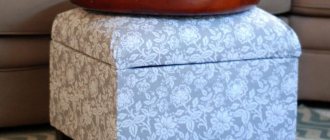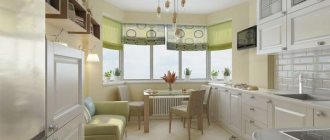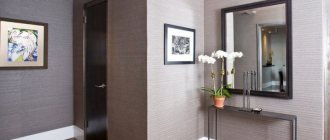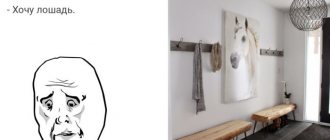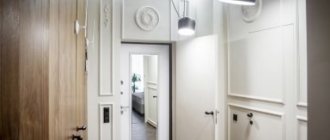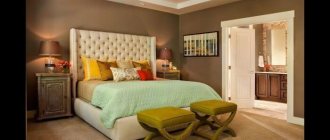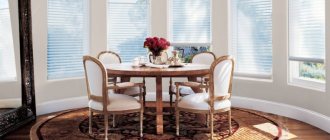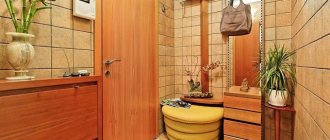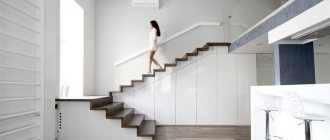Linear or one-way
Arrangement of shelving along one of the walls. There may be two options. In the first, the door is located opposite the cabinet. In this case, the distance between the opening and the drawers should be at least 0.8 m. Otherwise, using the furniture will be extremely inconvenient. A doorway at a narrow end is more convenient, making it easier to find things and change clothes. The minimum width of the room in this case should be 1.2 m, taking into account the depth of the shelving of about 0.55-0.6 m.
Instagram myfittedbedroom
Instagram kris_bagrova_design
Parallel or two-way
The shelves are placed in two rows, one opposite the other. A practical and roomy option, provided that the dimensions of the room allow it. Its length can be any, but the minimum width is 1.5 m. In this case, it will be possible to place furniture 0.55-0.6 m deep on one side, and narrower cabinets on the other. If you plan to install racks of equal depth, you will need a width of at least 1.8 m.
Instagram james_wellesley_joinery
Instagram lesorant_atelier
U-shaped
Three walls are used for storage systems, on which racks or shelves are installed. It is better not to use narrow rooms. Those whose shape is close to a square are suitable. The U-shaped option is considered one of the most practical, as it makes it possible to place a large number of things. At the same time, using such a wardrobe is convenient.
Instagram jenny_interiordesign
Instagram nikolai_bannikov_interiors
Wardrobe room - making a project
As you can see, there are a lot of ideas for warehouse equipment and systems. But so that it doesn’t turn out that the great thing you bought simply doesn’t end up in your wardrobe, you need to draw a plane on which you indicate all the sizes and dimensions. It is drawn to scale, so mark on it the details you need to request. They are drawn to the same scale.
If everything “goes well”, armed with the dimensions (you have them, or you can measure according to the figure and calculate the real values on a scale), you can go to the store to select systems.
There is another approach. Find out the dimensions of the devices and systems you like (installation dimensions), cut them out to scale from cardboard or thick paper and try to combine everything. If you can, you can buy. No, look for other options. As a result of your efforts, you should end up with approximately the same layout as in the photo.
An example of organizing space in a dressing room (indicating the minimum sizes for different types of clothing)
To make it convenient to use equipment and get things out, you need to maintain the following distances:
- minimum distance from shelf to shelf: when storing things - 30 cm; when storing shoes (without stilettos) - 20 cm;
- shirts, jackets, jackets - 120 cm;
- trousers: folded in half - 100 cm; length - 140 cm;
- compartment for outerwear - 120 cm; coat - 160-180 cm;
- for dresses - 150-180 cm.
On top we reserve space for clothes from another season or rarely used items. There is often space for a vacuum cleaner downstairs, and one of the cabinets has a built-in ironing board.
Finishing touches
In essence, the creation of a plasterboard dressing room is complete. However, there are a few more points worth paying attention to.
In particular, we are talking about the trampoline rod. It will bear the maximum load in the dressing room, so high-quality fastening should be carried out. It is best when the rod is attached not only to the drywall, but also to the profile, which is part of the frame. Then the entire load will go not to the gypsum board, but to the profile, which is much more reliable.
The question of doors also remains open. The easiest way is to purchase sliding doors with a special system so as not to do everything yourself. This option will be optimal in terms of saving space. It is worth thinking about ventilation. It's not very good when everything is clogged.
As a finishing coating, it is recommended to use wallpaper that matches the room. Gluing them requires minimal preparation of the drywall. And in this case, the dressing room made of plasterboard will merge with the room.
As for the different shelves, they can be made from different materials. These can be plasterboard shelves, but you need to know how to make them. If there are too many shelves, the work will be protracted. You can learn how to make shelves in a dressing room from the video.
How to make a dressing room: placement options
In a house, a storage room is also assigned at the design stage or later when allocating rooms. They are rarely found in standard apartments. Therefore, we need to find a suitable solution. Let's look at several possible options for what and where you can make a dressing room with your own hands.
In the hall
It would be good if the owner had a large room at his disposal, part of which could be taken out to organize a storage system for things. In this case, a partition is placed dividing the corridor into two rooms. The size and shape of the wardrobe is chosen according to your preferences.
In small apartments there are two solutions for how to make a dressing room in the hallway. The first is intended for long but rather wide rooms. There is a file cabinet on one of the walls. It is optimal to choose a closed wardrobe, possibly with mirrored doors. This will visually expand a small space. The second option is for square or cramped layouts. In this case, the corner is fenced off with a partition, and a storage system is installed inside it.
In the bedroom
It is customary to store clothes in the bedroom, so this solution is considered very appropriate. The space for the storage system is determined based on the shape of the bedroom. If it is too stretched, it is best to fence off the area across the room. The bedroom will acquire the correct proportions, become more comfortable and attractive. In fairly spacious, square and adjacent rooms, a corner placement of the dressing room is preferable. It is separated by a permanent partition with doors or a thick curtain.
Under the stairs
The free space under the flight of stairs is deep enough to accommodate a storage room. There are many options for arrangement. You can make an open cabinet or with doors: sliding or hinged. A modular design, which is assembled from retractable or retractable elements, is also suitable. Inside such blocks there are hooks, crossbars, shelves, and drawers.
Out of the closet
A boring wardrobe can easily be converted into a wardrobe if desired. The layout depends on the available space. The filling is pulled out of the old cabinet, leaving only the frame, which will become the basis of the new design. It is installed in place and the filling is installed. You can do things differently. Use old furniture as closet storage. Take some elements without changes, change them and repeat something.
From a niche
If the size of the niche allows, shelves and shelves are arranged inside. All that remains is to install the doors: hinged, sliding or compartment. The cabinet can be left open, but it should look attractive and neat, or covered with a thick fabric curtain. Small niches are complemented by a plasterboard structure, which expands to the desired size.
In the pantry
Older apartments often have a small, windowless room called a closet. Usually its area allows you to place a full-fledged dressing room in the interior. The filling can be anything, placed along the walls or the letter G. The door is closed with a curtain or a suitable door is installed.
Behind the partition
You can arrange the closet behind the partition yourself, without involving specialists. The partition can be improvised or stationary.
Homemade partition for a wardrobe.
Improvisation - using thick curtains to separate a room. The curtain is attached to the ceiling with a cornice or rod. The screen is suitable for a bedroom; behind it you can not only set up a dressing room, but also store bed linen, and, in good lighting, set up a boudoir with a mirror. But a model with a curtain will hardly look appropriate in the living room.
The second option is zoning with a plasterboard wall, this model is a little more complicated and expensive, but there are no problems with the location, it can be installed in any room. No permits will be required to construct such a building. This structure can be dismantled at any time.
What materials are best to use
You need to start assembling a wardrobe system by finding all the materials. You will need to make a frame and arrange a storage system inside.
First you need to separate a niche or room from the rest of the apartment. This can be done with a metal profile or a wooden beam (only in dry rooms).
At the entrance, a frame skeleton is built from the profile so that it can then be sheathed. It is attached to the walls, ceiling and floor using ordinary screws and dowels.
Sheathing occurs on top. Suitable for this:
- Drywall. The most common material, cheap and practical. It can be installed in an apartment without fear, since it does not absorb moisture from the air well, so you can use a dryer in the dressing room. In addition, plaster can allow moisture to pass through, so clothes will not “suffocate.”
- OSB. Orientated strand board consisting of large chips impregnated with resin. It is not afraid of moisture, but has an uneven surface. In this regard, the surface must be carefully puttied.
- Chipboard. It has a fairly uniform surface, does not require a large amount of putty, but is less resistant to moisture.
The interior arrangement consists of cabinets and special fitting racks (crossbars on which clothes are hung using “hangers”). You can buy cabinets or make them yourself from plywood or chipboard.
The racks are also easy to assemble. From the remains of the profile, you can assemble multi-tiered structures in several rows. A metal or plastic pipe will do.
You should not use a galvanized profile and pipe. If the zinc coating is damaged (during cutting, installation), moisture will begin to get inside. This will lead to rust of the inner steel layer and complete destruction of the rack within six months.
The last thing you need to take care of is the shelves. Perforated plates are best. You can buy shelves separately in the store or make them yourself. To do this, holes are made in a metal or plastic one (easier to make at home) in a random order. This is necessary so that the air from below can blow through the clothes.
Types of dressing rooms
There are two main types of locker rooms:
- Open
- Locked
Let's take a closer look at each type.
Open dressing room
An open dressing room suggests that the pantry is not separated by partitions or doors, but is a continuation of the interior.
Advantages of an open dressing room:
- Everything is in sight and within reach
- Convenient to arrange in small apartments
- The space of the room remains visually spacious
Disadvantages of an open dressing room:
- Everything is visible, including to your guests
- Items must be kept in perfect order to maintain the aesthetic appearance of the room.
Closed dressing room
A closed dressing room is located in a separate room or niche, which is fenced off with a screen or compartment door.
Advantages of a closed dressing room:
- The total area of the apartment is not cluttered with things, clothes, clothes, accessories.
- If there is no opportunity or time to clean up, none of the guests will notice from behind the door.
- A large and spacious walk-in closet can provide storage space for everyone in the family, no matter how big it is.
- There is a lot of storage space, which can be organized as ergonomically as possible.
- You can try on clothes, put them in order, iron them and get ready at any time of the day without disturbing the house (which is especially important if there is a small child in the house).
If you equip the dressing room with a large mirror or dressing table, then the dressing room will serve not only as a storage room, but also as a full-fledged dressing room.
Disadvantages of a closed dressing room:
- You need the place because of its location
- additional lighting required
- A living room with a closed dressing room becomes visually and functionally smaller
What to make shelves for storing clothes from with your own hands: choice of material
Laminated chipboard parts are a good and functional solution for storing clothes
There are several materials that are useful for decorating shelves in a dressing room:
- plywood
- tree
- drywall
- plastic
- Chipboard
Plywood is considered durable and wear-resistant, it is affordable and easy to install. Its only drawback is that it is sold in dimensional sheets, so after purchase you should immediately cut it into the required size shelves. Wood is also in demand - it is durable, hard, and has a pleasant texture.
By making a frame from plasterboard, you can build shelves from the same material. In this case, you need to take care of processing the edges of the shelves.
Plastic is suitable if the load on the shelf is small. Chipboard and laminated chipboard are in greatest demand. These boards are used for making furniture, so they will be ideal for shelves. They can be purchased ready-made or in large slabs and then cut.
Where to arrange a dressing room?
In a private house
In a private house, when creating your own design project, you can specifically provide a dressing room. It is best if it is in close proximity to the owner's bedroom or, if the family is large, in a place where any family member can easily (and without disturbing others!) enter.
If a special room is not provided, the dressing room can accommodate:
- Under the stairs
- In the large corridor
- Behind the bed
- In the attic
In the apartment
The likelihood that your apartment (especially in a Khrushchev-era building) will have a separate dressing room is even less than in a private house. Therefore, if the apartment area is not enough and you really want a dressing room, you should think about its location:
- In the pantry
- In a niche
- In the fenced part of the room
In an apartment, the dressing room can be separated from the living area of the room with a screen, curtain or doorways.
Wardrobe room layout
Depending on the area, the location of door and window openings, the number of things and the preferences of the owners, the arrangement of the dressing room can be done in different ways. Each of the presented options has certain characteristics that make it suitable for a certain type of room.
Linear layout
It resembles a family wardrobe, with the only difference being that the doors are completely absent or in their place there is a partition from floor to ceiling, and inside there is free space for moving along the shelves. This wardrobe arrangement is ideal for installation in a rectangular room along a blank wall or around a door.
Parallel layout
The optimal solution for rooms with an extended corridor, with a window or a large mirror in front of the door. In this case, shelves and hangers are located on opposite walls so that all things remain in sight and are easy to reach, and the spaciousness of such a dressing room can only be envied.
The presence of a window opening solves the problem of ventilation and daylighting, thanks to which a parallel layout can be recommended when initially designing a dressing room in a drawing of an apartment or house.
U-shaped layout
This is one of the most affordable options for arranging large walk-in closets. For comfortable use of the side walls, the central part must be at least 1.5 m in length.
This room has space for an ironing board, a chair (and sometimes a small sofa) and a mirror, resulting in a convenient dressing room.
Corner layout
It allows you to effectively use space in rooms with limited space: bedrooms, corridors, children's rooms, attics. Placing storage systems at a 90° angle allows you to store twice as much as a conventional linear cabinet.
You can separate the dressing room using sliding doors, both standard and round (semicircular). For high rooms, partitions made of plasterboard or plywood with a door are suitable; curtains and screens come in different types.
Principles of zoning a dressing room
Mandatory zones that a dressing room should have in a house or apartment: - bosses, - middle, - Lower, - place for hats.
The criterion for distributing clothing is the frequency of use.
The upper zone is an alternative to mezzanines; it is placed at least 190 cm. These shelves contain seasonal items that are in demand a couple of times a year. To reach them you will need a ladder.
The central zone is for storing clothes and linen for every day. There is a bar for outerwear, hangers for trousers and ties, and shelves for linen. In the same area, the dressing room design usually includes an ironing board.
The lower part is a place for boots, sandals and shoes. They are stored in special storage boxes and rarely used shoe boxes.
Directly above the central area there is a compartment for hats and caps. Each cell must have a minimum size of 25x18 cm.
Design and organization of a dressing room
The choice of dressing room interior depends on who will use it and what style the entire apartment is designed in.
Women's dressing room
Women's dressing rooms are often decorated in light colors. If space allows, a dressing table and pouf are installed inside. Often a carpet is laid on the floor, and the walls are decorated with paintings.
Most often, the women's dressing room is decorated in a classical style or has elements of Rococo and Baroque. The use of stucco and other decorations is allowed.
Men's dressing room
This is often done in dark colors using wood. Much attention is paid to the functional side: storage of ties, watches and cufflinks, convenient hangers for trousers and dresses.
Children's dressing room
If the children's room is spacious enough, you can separate it into a dressing room. They try to arrange it in such a way that it is convenient for the child to sort out his things and put them in their places.
This dressing room is decorated in light colors, and a lot of attention is paid to the decor, which will turn the cleaning process into an exciting game. For older children, a more discreet design is suitable.
Universal dressing room for the whole family
When planning it, the number of those who will use it is taken into account - everyone should have their own section. Based on the number of things that are planned to be stored here, the number of shelves, racks and space for hooks is calculated.
It is important to analyze your wardrobe and understand what storage compartments each family member will need.
Wardrobe for two
Dressing room decoration
Once you have removed unnecessary debris from the area where the dressing room will be located, made the right design plan and chosen a style, you can begin to decorate it.
First you need to make ventilation that can pass air into a confined space. Things must be in a well-ventilated place, otherwise they will quickly become unusable. It is also necessary to pay attention to the lighting equipment, because daylight does not penetrate into the dressing room, so it is better to think about bright lighting in advance.
Materials
The dressing room should be functional. As a rule, modules in wardrobe systems are made of wood. A cheaper option may be to make cabinets and drawers from chipboard or MDF.
Hinged doors can be made of plexiglass. In this case, you will always see what is in a particular box.
It is better to choose cellular exhaust baskets made of plastic - they are lightweight, easy to care for and look good.
It is better to choose metal stands for hooks; they are reliable and their appearance does not deteriorate due to constant scratching by hooks.
A small dressing room is best furnished with light-colored furniture.
Walls
You need to start finishing the dressing room from the walls. Use special tools to remove old plaster. Get rid of the wallpaper, as it will not be needed later in the plan. The walls need to be leveled with new materials. If left in the same position, the racks and shelves will most likely not be evenly spaced.
Drywall can be used for precise alignment of walls, as well as PVC panels. With this choice, a corner of the corresponding color is used to connect the ceiling and walls.
Floor
Having previously completed work with the walls, it is necessary to carefully consider the finishing of the floor, since a person will stand for a long time and choose clothes, which means that the floor should be covered with a pleasant and comfortable material. In this case, linoleum or laminate is used, depending on quality and price.
Ceiling
After covering the walls, the ceiling is made to match. If PVC panels were used, it is necessary to cover the top of the room with them so as not to deviate from the style and color of the room. In addition, it is necessary to take into account the color of the furniture and components of the dressing room.
If you have a high ceiling, you can use drywall to make the room look even and tidy.
Storage system
Before installing furniture in the dressing room, you need to prepare it. First of all, it should be dry here, so you need to create ventilation. It is not recommended to create a storage room in a corner of a building that is prone to getting wet and not exposed to sunlight. It is undesirable for it to have a common wall with the kitchen and bathroom. If there are no windows, a fan can be installed for ventilation, which can automatically turn on after a certain amount of time.
It is equally important that the dressing room is protected from the penetration of foreign odors. Bags filled with dried aromatic herbs will give the room a pleasant aroma. And essential oils are used to protect things from insects.
Storage systems can be purchased or made independently. In order for all things to fit comfortably, you need to calculate the number and size of the required compartments. For example, it is important for a woman that the height of the hangers allows her to store her clothes here, including long ones. Therefore, they must be at least 1.8 m. For storing men's jackets, 1.2 m will be enough. The size of the shelves should be from 30 to 35 cm. The width of the shoulders can affect the depth of the closet. Therefore, it is usually 50-70 cm.
The top of a walk-in closet is typically used to store blankets, pillows, bags, and seasonal items. Umbrellas, gloves, hats and bags can be stored just above eye level. The central part is occupied by shelves and hangers, under which there are drawers for linen. The bottom tier will be occupied by shoes. It is more convenient to store it on rotating structures or on shelves with an inclination angle of 45-60 degrees.
To make it easy to find the right thing here, the dressing room must have high-quality lighting. Lamps with warm or neutral light are suitable. LED spotlights installed in the shelves will not be superfluous here. Conventional lamps can be replaced with small spotlights that can be oriented in any direction.
Shoe storage systems
Convenient shoe storage using inclined shoe shelves or racks, choose the one that suits you in a particular case.
Shelves for shoes in the dressing room.
Open shelves with compartments like mailboxes, shelves without dividers - suitable for a narrow dressing room, shelves 35-45 cm wide, drawers, inclined shelves, special baskets, open shelves on special supports are enough to adjust the height of the shelves.
Special shelves for shoes in the dressing room.
If the shelves are open, they are located under the compartments for winter clothes. Adjust the width according to your shoe size, about 30-35cm for summer shoes, 40-45cm for winter shoes.
Clothing storage systems
Clothes storage systems in the dressing room.
The correct location in a “smart” closet determines the number of things that can be placed in it, the convenience of their placement and the quick search for what you need.
Arranging a dressing room.
Long winter clothes: provide enough hook rods, the height of this compartment should be at least 150 cm.
For short dresses, shirts, blouses, jackets, etc. Area 90 cm high with hanger bar.
For skirts and trousers, it is convenient to use multi-tiered hangers or a trouser system.
Dressing room trousers.
Underwear is stored in drawers or organizers, on shelves.
Organizer for linen in the dressing room.
You can make the most of your closet wall space by using a scissor lift for items hanging on the top level of your closet. This device will allow you to divide the room into zones according to the current season.
Doors and mirrors
Having found a place for a dressing room, determine the door. The door, first of all, should be in harmony with the interior and palette of the apartment. Secondly, do not take away even a few centimeters of useful and scarce space.
As for the latter, the locker rooms are mainly equipped with hinged and sliding doors. In this case, the width of the opening must be at least 60 centimeters.
Inserts made of corrugated, patterned or colored glass will turn any door into an original accent object.
Doors made of frosted glass are deservedly popular, allowing for increased lighting in the dressing room. They can be plain and not noticeable... Or, on the contrary, shimmering with a lacquered box and patinated fittings, making the interior more sophisticated.
The mirror can be a separate attribute if the dressing room is large, or it can be combined with the wardrobe door. Another thing is more important: it must be large, full-length and well-lit. It's even better when there are several mirrors. This is necessary not only for an adequate assessment of your image; mirrored walls “pushed” the boundaries of the dressing room.
Lighting
Lighting is one of the main figures in the dressing room. This is not a place for experiments - the light in the dressing room should be as natural, uniform and detailed as possible.
To achieve the desired result, use both a chandelier and built-in lamps. The latter are mounted on the ceiling and on the wall around the perimeter of the cabinet, illuminating the shelves and mirror.
Especially for the dressing room, designers advise purchasing mobile lamps attached to clothespins. This lamp is easy to remove, move and direct the light in the desired direction.
Ventilation systems
Ventilation is another important indicator of an ideal locker room. It must be thoughtful and, perhaps, even forced, because in the dressing room, as a rule, there is no window or natural ventilation.
It is also advisable to reserve space for bags of aromatic herbs, balms and moths.
In particular, this problem is relevant for small dressing rooms and rooms where outdoor shoes and outerwear are stored.
High humidity quickly affects the cleanliness and hygiene of the room. As a rule, 2-3 crossbars and 1 ventilation shaft are installed in a closed dressing room.
Practical advice
- Glass walls on drawers or boxes make searching for things faster.
- Provide moving objects, they are useful. You can take the ottoman from the dressing room to another room for changing clothes, or you can use it as a stand to climb into the far upper corner of the closet.
- Organize things by color and find them faster.
- Inclined shoe storage systems are more convenient than horizontal ones.
- Use pantograph lifts to increase storage capacity and accessibility of items in it.
- To spend less time re-ironing, don't skimp on hanger compartments.
- 30–35 cm is the optimal depth for a comfortable shelf.
- Don't ignore the compartments for linen and long-term storage. They are always needed.
- The accessory organizer takes up little space. Provide for it.
You may be interested in: What does a built-in dressing room look like, the nuances when developing a project and choosing the appropriate option
The question of choosing a dressing room depends on your needs and capabilities. We tried to reveal the pitfalls of the issue as briefly as possible. All that remains is to choose a project and build a dressing room with your own hands.
General style
For an open wardrobe there is not much choice - it must match the room: either exactly match the style of the room, or at least fit harmoniously into it.
A closed closet offers more choice, especially when the closet occupies a separate room. In this case, the style of the dressing room is not tied to the rest of the house.
This is your space, and you decide what it will be like: chic or not, fashionable or not. But remember that the dressing room does not “receive” guests, so practicality comes before luxury. Let order, cleanliness, coziness and comfort reign here. These qualities can easily be embodied in a classic or casual style. If you want to add some elegance to your wardrobe, no one has the right to stop you.
Conclusion
A dressing room is not a luxury, but a very rational design for storing all your things; you can do without closets, which will make your rooms more stylish and modern. The video in this article will help you understand some of the nuances in more detail, and if you have questions on the topic, write them in the comments under this review.
Did you like the article? Subscribe to our Yandex.Zen channel
September 28, 2016
Plasterboard systems, Design, Design of other rooms
If you want to express gratitude, add a clarification or objection, or ask the author something, add a comment or say thank you!


